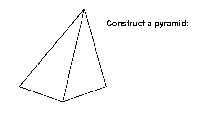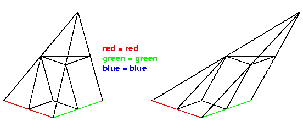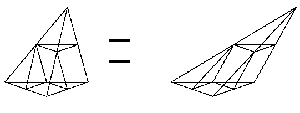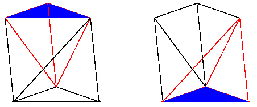Euclid Book XII Proposition #7
By: James Seaton
December/05
The purpose of Euclid's 7th Propostion of book XII is to show in
a roundabout way that the volume of a pyramid with triangular base is:
(1/3)base x height
Before the proof is shown, a number of propositions necessary for
this proof should be outlined:
-
Euclid VI prop. 2
If a straight line is drawn parallel to one of the sides of a triangle, then it cuts the sides of the triangle
proportionally; and, if the sides of the triangle are cut proportionally, then the line joining the points of section
is parallel to the remaining side of the triangle
-
Euclid VI prop. 5
If two triangles have their sides proportional, then the triangles are equiangular with the equal angles opposite the corresponding sides.
-
Euclid XI prop. 39
If there are two prisms of equal height, and one has a parallelogram as base and the other a triangle, and if the parallelogram is double the triangle, then the prisms are equal.
-
Euclid XI prop. 28
If a parallelepipedal solid is cut by a plane through the diagonals of the opposite planes, then the solid is bisected by the plane.
-
Euclid XI prop. 32
Parallelepipedal solids which are of the same height are to one another as their bases.
-
Euclid X prop. 1
Two unequal magnitudes being set out, if from the greater there is subtracted a magnitude greater than its half, and from that which is left a magnitude greater than its half, and
if this process is repeated continually, then there will be left some magnitude less than the lesser magnitude set out.
-
Euclid I prop. 34
In parallelogrammic areas the opposite sides and angles equal one another, and the diameter bisects the areas.
Also, I should define what Euclid means by "equal and similar":
-
Euclid XI def. 9, 10
XI def.9 - Similar solid figures are those contained by similar planes equal in multitude.
XI def.10 - Def. 10. Equal and similar solid figures are those contained by similar planes equal in multitude and magnitude.
Since XII prop. 7 isn't as interesting as the propositions leading up to it
I've included my own interpretations of the special cases of XII 3, 4 and 5 necessary:
Euclid XII prop. 3
A pyramid can be divided into two pyramids, equal and similar to one another, and each similar to the whole,
and into two equal prisms, and the two prisms are greater than half of the whole pyramid:
 click picture to see the proof
click picture to see the proof
Euclid XII prop. 4 (special case)
If two pyramids hae the same height with equal triangular bases, with all corresponding sides of their bases
equal. and they are divided into two similar and equal pyramids, and into two equal prisms, then all four prisms are equal
to one another
 click picture to see the proof
click picture to see the proof
Euclid XII prop. 5 (special case)
If two pyramids have equal heights with triangular bases that are equal and similiar, then the pyramids are also equal
 Click picture to see the proof
Click picture to see the proof
Now, without further ado: The proof of Euclid XII prop. 7!!!
Any prism with a triangular base is composed of three equal pyramids with triangular bases
 Click picture to see the proof
Click picture to see the proof
So why do we conclude that the volume of a pyramid with triangular base is (1/3)base x height ?
Because: Volume(prism with triangle base) = base x height
And:
Volume(prism with triangle base) = 3 x Volume (pyramid with same triangle base)
So:
Volume(pyramid with triangle base) = (1 / 3) x Volume(prism with same triangle base)
Therefore: Volume(pyramid with triangle base) = (1 /3 ) base x height
|
 click picture to see the proof
click picture to see the proof
 click picture to see the proof
click picture to see the proof
 Click picture to see the proof
Click picture to see the proof
 Click picture to see the proof
Click picture to see the proof
 click picture to see the proof
click picture to see the proof
 click picture to see the proof
click picture to see the proof
 Click picture to see the proof
Click picture to see the proof
 Click picture to see the proof
Click picture to see the proof